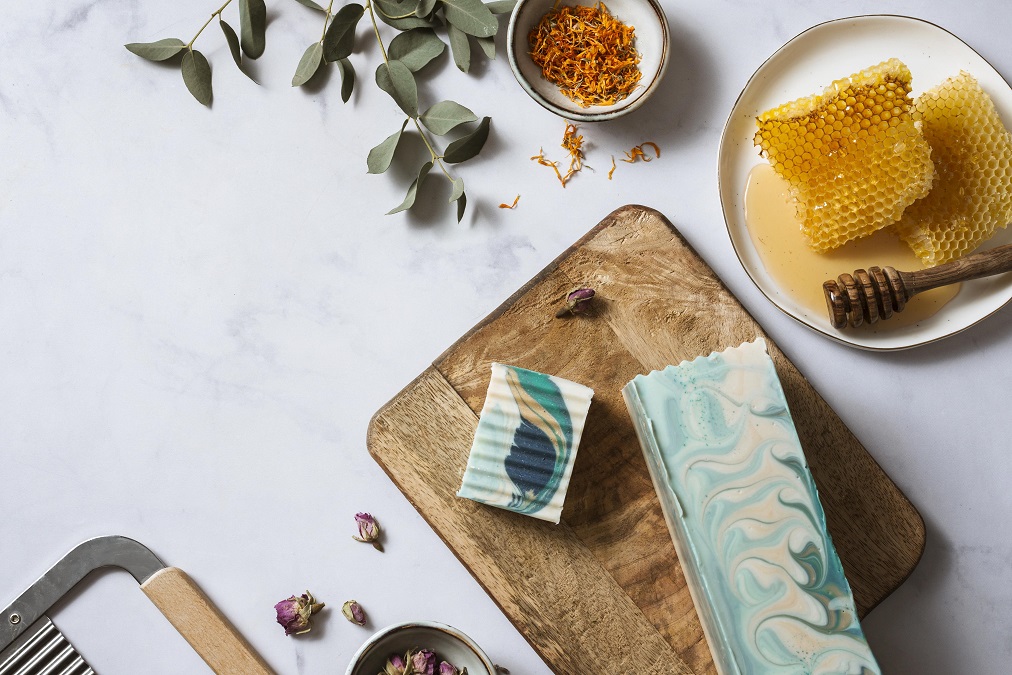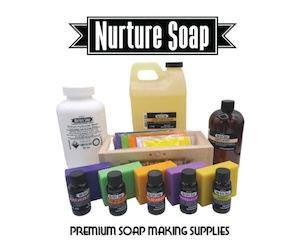Soda Ash In Soap Making:
So you’ve got a soda ash problem, huh? Truth is for some, soda ash is a larger problem then for others. To be clear, soda ash is a pretty normal part of cold process soap making. Today we’ll talk soda ash in soap making.

If you’ve never run into the problem, then likely you haven’t made enough soap, just kidding, but really! So why do some people not care? Many soapers, make soap just for themselves or their family. Thus, having some soda ash (which is not harmful) on their end product, is just not that big of a deal. They care about the product itself, meaning that they know every ingredient that was placed into the formula. In addition, that all of them are safe to use and skin-friendly.
We’ll be honest, however. Even if we were making soap just for ourselves or our family (which we do), we want them to look awesome. Soda ash to us, just doesn’t look that awesome!
At Rn to Zen, we obviously sell soaps, so the aesthetic part of it means a lot to our customers, and we know this. Thus, we do everything we can to prevent it, and that’s what we’ll discuss today!
How can we prevent soda ash in the first place? If we don’t prevent it, what now?
Truth is, sometimes it just happens. However, there are ways to help prevent it (if that’s your goal). Consequently, increasing the chances that your soap turns out just the way you desire.
Related Article: The Not So Beautiful River: All About Glycerin Rivers & Prevention In Cold Process Soap
What is Soda Ash in Soap Making?
Soda ash is actually pretty common in the soap making process. If you’ve never seen it, it’s a whitish, beige, “ash” looking film that develops “usually” on top of your bars of soap. It is not harmful. It does not ruin the actual soap product. However, aesthetically it may not be as pleasing as you desire.
So why does it happen?
In laymen’s terms, it happens when lye in your soap reacts to the air. If you want a more complicated answer, it’s when the unsaponified lye reacts with carbon dioxide.
As mentioned earlier, it usually appears on the top of your soap, but can work its way down into the soap as well (down the sides, etc.). If you’re someone that unmolds soap after 24-48 hours, even if it’s set, you may still have some development of soda ash after unmolded and cut.
Related Article: Let’s Talk Soaping Molds. Is There a “Best” Soap Mold?
How to Prevent Soda Ash In Soap Making:
So, how can you prevent soda ash in soap making, especially in cold process soap making where lye is used?
Alcohol: One of the easiest ways to prevent the formation of soda ash is to spray the top of the mold right after you pour your batter. This helps to create a sort of barrier. Sometimes, we spray the soap once right after our pour then cover. In 5 minutes we’ll uncover and spray it once more.
Cover: We mentioned this above. Cover your soap and the mold. Don’t just throw a towel on it and be done with it. Really cover it. Construct a flat piece of cardboard or even something transparent like plexiglass and cover the soap, making it as air tight as possible. Then, cover or wrap with towels.
Gel it: Covering our soaps helps to trap heat. This in turn helps force the soap through gel phase which is another preventative measure for soda ash.
Quick Tips On Forcing Gel Phase:
- Climate Control: be mindful of the climate of your home and/or where you’re soaping.
- Heating Pad: another idea to force soap through gel or is by placing it on a heating pad for 30 minutes, then shutting it off. The trick is not to heat it up to much. To much heat can cause other issues and completely ruin your batch.
- Oven Method: We learned this a while back from Tree Marie Soapworks. The idea is to use the preheat setting on the oven to gently force gel. Again, be careful not to overheat. We place a see though barrier on the top of the molds (so we can peak through the oven glass to make sure it is not overheating). Preheat the oven to the lowest setting, place the soap in the oven and turn off the heat. This is an easy trick if you soap at night, because you can just leave it in the oven over-night and take it out in the morning.
Okay Let’s Get Back On Track!
Medium Trace: If your soap design is not to detailed and doesn’t contain elaborate swirls, this is an easy alternative. Wait until your batter is at medium trace, then spray the top with alcohol, and insulate.
Higher Temps: We find that if you do the steps above you can pour even cooler then 100 degrees and be just fine. However, another trick is to soap around 110-120 degrees. This means both your lye solution and oils are in that range or close to it.
Water discount: If you don’t know what a water discount is, read more about water discount here. There is more then one reason to do this. By doing a water discount, this helps not only with soda ash, but most likely you’ll be unmolding your soap hours earlier, and possibly preventing other issues like glycerin rivers.
Be patient: Your soap can still ash, even if you’re able to unmold it after 24-48 hours. Make sure it has cooled thoroughly.
You Did All Of These Steps and Still, Ash!
The sad truth is, if you did all of these things, your soap may still ash slightly. Sometimes, it’s about refining your skills, and being more efficient with your process. So, if you’ve done these things and still have some ash, you can do a few things that may help!
If you’re selling soaps and you have soda ash (fairly severe), going all the way through your soap, it may be worth re-batching. Alternatively, keeping this batch for your own use. It’s efforts might be to time consuming then it’s worth, and may still not take care of the issue, aesthetically!
Steamer (favorite method): This is our favorite. If you do all the prevention methods to halt the formation of soda ash, oftentimes you’ll have no ash or just a fine layer on top the cured soap. The steamer works great for this purpose. You can also use it with intricate top designs where you may have grooves and ridges.
Dependent on how bad the ash layer is, may depend on how long you steam in one spot. Be careful not to over steam. Again, practice and see what works for you. So much of soap making it trial and error.
Tip: Sometimes we steam our soaps even if they don’t have soda ash, as the heat gives a beautiful sheen to the soap.
Give them a Shave: If you want your soap tops to be flat, and you have a thin layer, invest in a soap shaver and just plane the tops. It looks clean and professional as well with even sides. If you have a purposeful ridged top, that’s where the steamer is nice to have.
Distill Dip: We have been less successful with this trick. However, you can also try to dip your bars (individually) into cool distilled water.
- put on gloves so you don’t pick up your fingerprints on the soap.
- dip the soap quickly into a small bucket of distilled water. In-Out.
- Shake lightly: shake the bar lightly
- Set aside: Set to dry on a soft cloth, or other material that will not transfer prints.
The problem we have found with this method is, if you use a decent amount of soft oils in your batter, even if you’re bars feel like they’ve hardened, the bottom often pools with to much liquid.
Even the slightest amount of excess water can cause the bottoms or corners to get a bit un-formed.
Again, it’s about technique here as well. This method also gives the bars a glossy look, like the steamer.
Related Article: Cleanup & Safety Tips for Soap Making: Let’s Chat About it
Final Thoughts!
Well that’s it, soda ash in a nutshell! Hopefully you don’t run into soda ash too severely, or too regularly as you refine and try different techniques in soaping. However, if you do, reference back to this page for help!
Thanks for stopping in and happy soaping!
Resources:
- https://www.diynatural.com/soda-ash-in-soap-making/



